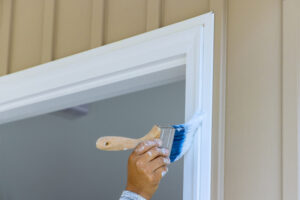
Best Paint for Trim and Baseboards
Baseboards and trim can elevate the appearance of your home’s interior, but even the most ornate trim piece will look dilapidated if it is not
Metal is one of the more difficult surfaces to paint because most paint doesn’t adhere well to it. It also is prone to rust and oxidizing, so any paint you choose must be able to protect the metal. Preparation is also key to protecting metal with paint. Luckily, Vista Paint has a line of paints specially formulated for use on metal.
Spray paint is the usual go-to for metal painting, but the application is uneven, which results in a streaky finish. Brush-on paint takes longer but the finished product is much higher quality.
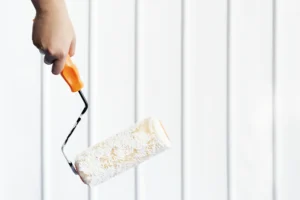
Brushes and paint trays are ideal for painting metal since they make for even application. If the metal has been painted in the past, it will need to be scuffed and cleaned to remove old paint and oil. An N-95 mask is handy here to protect your lungs from particulate matter.
Rust remover and acetone may also be required if the metal has visible rust. Painting over rust will cause the rust to bleed through your new paint, so it should be treated and removed.
You also need to identify your metal as ferrous (containing iron) or non-ferrous. Ferrous metals are steel, cast iron, wrought iron and are often prone to rust. Non-ferrous metals include aluminum, copper, zinc and stainless steel.
Finally, you need the right primer and paint. Vista Paint recommends 4800 Metal Pro Primer for non-ferrous metals. It protects them from rusting and improves adhesion so the paint doesn’t peel off after application. For ferrous metals, Vista Paint recommends 9600 Protec Metal Prime. This is not recommended for galvanized surfaces, but it does protect ferrous metals from corrosion and improves the overall finish.
For paint, Vista Paint recommends 9700-9800 Protec Metallic, which is formulated especially for interior and exterior metal surfaces. Take care not to shake the container and don’t store it near any open flames.
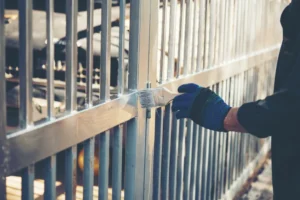
Once you’ve identified your metal, any old paint will need to be removed with a wire brush. A heavily rusted area needs rust remover applied to the surface to eliminate any remaining rust and allow it to be scrubbed off the surface.
An acetone-dipped rag can remove grease and oil from the metal’s surface, making it ready to receive primer.
Scuff the metal if it’s smooth with a scuffing pad. This gives the primer something to cling to. Scuffing isn’t necessary for corroded surfaces as they are already rough to the touch and will hold primer readily once prepared.
Galvanized metal has zinc in it, so scuffing galvanized metal can actually remove the zinc layer, leading to further rust in the future. Galvanized metal shouldn’t be scuffed or sanded. Wear an N-95 mask while scuffing metal to avoid inhaling particulate metal.
Priming metal seals away any rust and protects it from future damage. It also acts as a moisture barrier, preventing the introduction of new rust. Make sure to choose the right primer for your metal. Make sure your primer is compatible with your intended paint.
Read the label carefully to review drying times and cure times. If you paint over the primer before it’s ready, then your paint can peel or flake. By following the instructions to the letter, you will get the best results out of your paint.
Metals going outside may need a second coat to provide extra protection against oxidation. Apply the primer evenly, making sure that everything is covered. Primer can be white or rust colored.
Once the primer has dried fully (out of direct sunlight and wind), you can add your paint. Apply the necessary number of coats for the coverage and color saturation you’re wanting. Allow the paint to dry between coats. It will need at least 36 hours to fully dry. Make sure it’s not exposed to direct sunlight while it dries.
Highly pitted metal may not be structurally sound enough to take paint.
Metal paint both decorates and protects metal from further corrosion. For metal paint indoors, the environment is generally regulated unless the metal is stored in a bathroom or garage. Metal outdoors is exposed to varying levels of moisture, sunlight, temperature swings and more.
By painting the metal, you are protecting your item for the long term. Furniture with metal parts will resist corrosion and rust, making them structurally safe and sound.
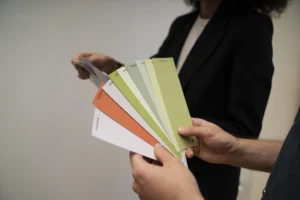
While most metal primers are either white or rust-colored, you have a lot of options when choosing a color for your paint. Metal paint tends to look better with a matte finish so it looks powdery. Some pigment can include iridescence or a little gloss to add a shiny finish.
Consider how your chosen color will look in different lighting and how it will function. Metal furniture, for example, may need a lighter color so it’s less hot to the touch while metal frames can use darker colors to best effect.
Prepare the metal outside if you can – that includes scuffing. This makes for easier cleanup. If you have to scuff indoors, then use a drop cloth and a shop vacuum to clean up any residue so your final product is clean and easy to paint.
If you’re painting outside, avoid painting in direct sunlight. Heavy sun can dry paint too quickly, leading to your final product drying with streaks. Avoid painting in the wind for the same reason. Wind can also blow debris onto your wet paint, giving you a new area you may have to sand and repaint.
Metal paint is a colorful alternative to clear coats and can customize your outdoor furniture, interior decorative pieces and wrought iron fencing to your liking. A fresh coat of metal paint not only preserves your items for future generations, but it improves the appearance and texture. Think about the times you’ve touched rusty metal – or worse, sat on a rusted chair. A fresh coat of paint will make everything more visually appealing and practically useful.

Baseboards and trim can elevate the appearance of your home’s interior, but even the most ornate trim piece will look dilapidated if it is not
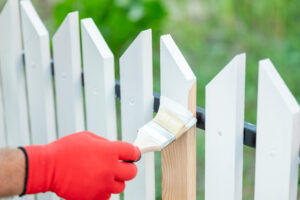
You’ve just installed your beautiful new fence! Now, while it cures, you have the difficult decision of choosing a stain or paint color. With all
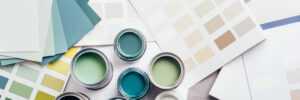
How to Find the Right Color for Your Interior Paint Job Have you procrastinated painting the walls in your home because you’re worried you won’t

Baseboards and trim can elevate the appearance of your home’s interior, but even the most ornate trim piece will look dilapidated if it is not

You’ve just installed your beautiful new fence! Now, while it cures, you have the difficult decision of choosing a stain or paint color. With all